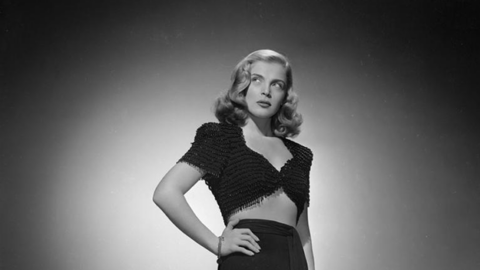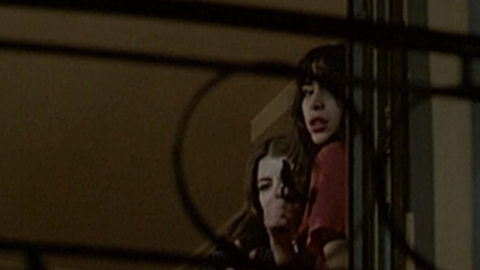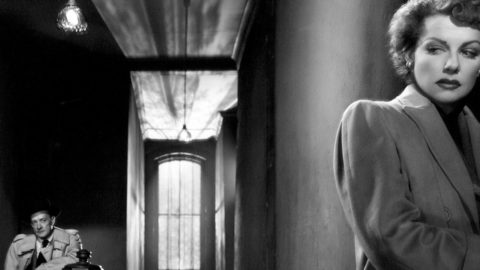TCM Diary: Gerd Oswald
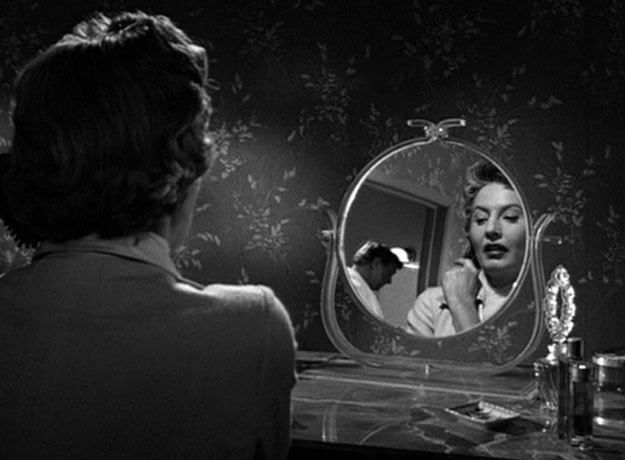
Crime of Passion
When talking about the body of postwar American crime films that have been grouped together under the heading of film noir, one frequent item of discussion is the unease of the returning serviceman adapting to stateside civilization. Just as important to these films, however, was a sense of the purgatory that awaited once that adaptation had been made, if it needed to be made at all. The stifling complacency of superpower prosperity and all the suburban trimmings that came with it is achingly evident, for example, as early as Dick Powell’s exhausted breakfast table performance in Andre de Toth’s Pitfall (1948). Sometimes it was the domesticated man who would succumb to the itch for adventure, of longing for something more, while in Byron Haskin’s Too Late for Tears (1949) it’s Powell’s Pitfall co-star Lizabeth Scott who turns to larceny from sheer boredom. Very few films, though, have gone quite so far in expressing a woman’s experience of connubial bliss as a kind of torture chamber as has Gerd Oswald’s 1957 vehicle for Barbara Stanwyck, Crime of Passion.
Oswald was a household name neither during his life nor afterward, so an introduction is probably in order. I’m told it’s pronounced “Gert,” for starters. He was born in 1919 in Berlin to Richard Oswald, a prolific film director whose career began in the silent period, continued through the 1940s, and encompassed stopovers in France, the United Kingdom, and the United States, where the Jewish Oswald had gone along with his family to escape the Nazi threat. Gerd would have been around 20 when the Oswalds arrived in Hollywood, and if his IMDb resume is to be believed he had already been working as an assistant for his father and others since he was a teen barely out of short pants. In his new home he soon found work as an assistant director, eventually working for some rather distinguished names: for George Stevens on A Place in the Sun (1951), on Niagara (1953) for Henry Hathaway, and on A Foreign Affair (1948) and Sunset Boulevard (1950) under Billy Wilder, whom he’d first met when a child in Vienna.
Oswald’s feature debut, A Kiss Before Dying (1956), showed the mark of all these experiences, particularly that of A Place in the Sun—in fact the film was adapted from a 1953 novel by Ira Levin, though Levin himself might very well have been inspired to write his story of working-class striving warped into murderous avarice by Stevens’s adaptation of Theodore Dreiser’s An American Tragedy. The protagonist of A Kiss Before Dying is Robert Wagner’s Bud Corliss, an All-American high school sports star who lost a few good years in a Korean foxhole and is eager to make up for lost time and get ahead in the world by marrying classmate Dorothy (Joanna Woodward), who comes with the biggest copper ore mine in Arizona for a dowry. Dorothy, however, has gone and gotten pregnant with Bud’s baby. This means that Dorothy will lose her inheritance, and Bud will lose his freedom to maneuver, and that doesn’t work for Bud, so Dorothy goes off the roof of the tallest building that Bud can find, and he starts the whole seduction process over again with her sister (Virginia Leith). In Bud, one real cold-fish son-of-a-bitch, Wagner and Oswald create a smooth, smug monster of ambition, while DP Lucien Ballard uses the widescreen DeLuxe color frame to create a series of intricate studies in entrapment. It’s a hell of a movie, in the most infernal sense of the saying.
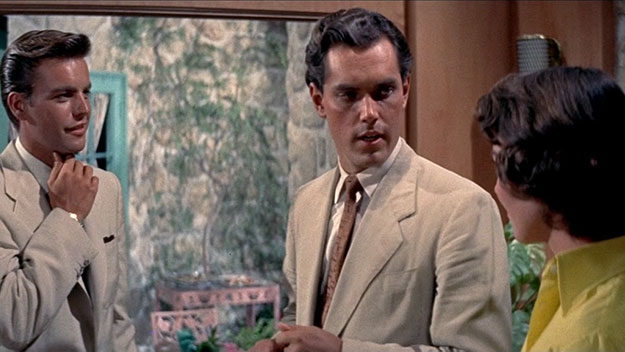
A Kiss Before Dying
Levin would go on to earn his measure of pop cultural immortality authoring the novels Rosemary’s Baby and The Stepford Wives, thrillers reflecting the vulnerable role of women in contemporary society, while Oswald would turn out a few more American tragedies of his own, including Screaming Mimi (1958), an adaptation of Fredric Brown’s pulp classic starring Anita Ekberg, and of course Crime of Passion. When we first encounter Kathy Ferguson, that film’s protagonist, she’s working as an advice columnist at a San Francisco newspaper. She is hard-nosed, ambitious, and gives as good as she gets when dealing with the condescending little men around the bullpen. She’s the kind of no-nonsense career woman that proliferated in American films of the 1930s and early ’40s, when Stanwyck was first hitting her stride, but had all but disappeared by the 1950s, swallowed up by the cult of domesticity which consigned the woman to hearth and home. So, too, will Kathy—a close relation to Stanwyck’s reporter in Capra’s Meet John Doe (1941)—and her ambitions soon be sacrificed on that same altar.
But first: Kathy sees and seizes her shot at the big time when the sensational story of a murderess from Los Angeles on the loose in the Bay Area first breaks. She strongarms her editor into running a heart-wrenching open letter promising the fugitive sympathy and support in the paper—“Where can we turn,” asks Kathy’s copy of the piteous plight of the Weaker Sex, “except to the heart and understanding of another women?” Kathy’s manifesto of sisterly solidarity touches a nerve, and in montage we see it being absorbed by San Franciscan women of all walks of life, among them a pair of distinctly butch cab drivers. In one swoop the film establishes the universal resentment shared by the American woman towards her plight in life, and also Kathy’s particular genius for emotional manipulation—when the fugitive does show up and throw herself on the mercy of the law, posturing savior Kathy promptly turns the poor girl in to be transported back to L.A., and is never seen to give her another thought. The resulting media frenzy lands Kathy the big gig she’s been gaming for in New York City, but there’s just one catch: The arresting officer, Lt. Bill Doyle, is a little sweet on Kathy, and he’s played by that lumbering Viking Sterling Hayden, and she has an awfully hard time turning him down when he asks her to come through southern California before she heads out east.
Well, Kathy never gets to New York—instead she gets the last name “Doyle” and a little house in the suburbs and her share of a cop’s salary to stretch as far as it will go. When Bill and his bride first come home from city hall as man and wife we are treated to a “wedding night” scene in broad daylight which is unusual in American pictures of the period for its air of real sexual hunger, but the honeymoon doesn’t last for long. Instead of the exciting, unpredictable give-and-go of the workplace, Kathy discovers that the social ceremonies of the LAPD are numbingly regular, and rigidly divided by gender—husbands sipping flat beer and playing poker and jawing about their pensions; wives dispensing empty flattery and nattering about the hors d’oeuvres. In depicting incessant small-talk as a kind of water torture drip on a delicate sensibility, the movie pulls up just short of R.W. Fassbinder and Michael Fengler’s 1970 Why Does Herr R. Run Amok? And the connection between these two German filmmakers a generation apart, both deeply invested in the experience of domestic despair, is not so obscure as it may seem—both favor compositions with characters facing front-forward, creating an effect both confrontational and alienating.
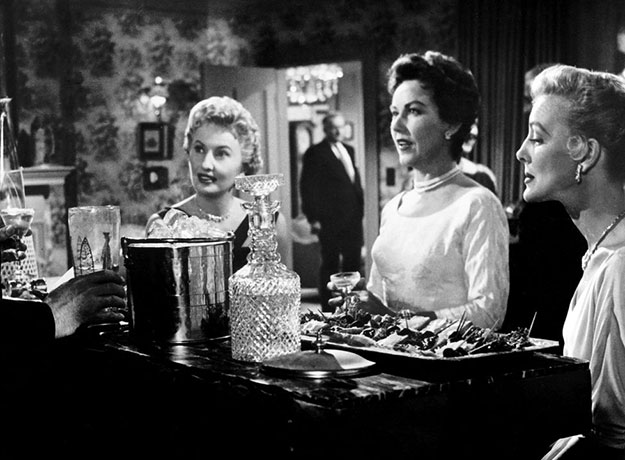
Crime of Passion
It’s around this time, to the surprise of no viewer familiar with Stanwyck’s screen persona, that Kathy Doyle discovers that Kathy Ferguson’s ambition didn’t dry up just because of a name change. (The film interfaces intriguingly with Stanwyck’s near-contemporary melodramas for Douglas Sirk, 1953’s All I Desire and 1956’s There’s Always Tomorrow.) Instead of pushing her own career, she becomes a tireless champion of her husband’s, faking a fender bender so that she can get in with Alice Pope (Fay Wray), the wife of the head of Bill’s division, Inspector Tony Pope (Raymond Burr). Himself adept at figuring all the angles, Pope has Kathy pegged as a merciless striver from the get-go, and they strike up an understanding of sorts: She comes up to his office to pore over profiles in abnormal psychology, and he condescends to kick Bill up the chain of command a bit. But even Kathy’s finally succumbing to his sweaty clinches isn’t quite enough to sway Pope to put lummox Bill in a position of high command, and so there is trouble, and a gun is discharged, and Kathy’s clawing her way to the top ends, presumably, in the slammer—the last time see her, the doors of the station house elevator are closing on her like a casket.
A just comeuppance for an uppity dame who doesn’t know her place, or the final insult to a woman whose only sin was being born into a society that provided no outlet for her will to power? The script of Crime of Passion is credited to Jo Eisinger, an ex-newspaperman, sometime novelist, and a Hollywood vet, with credits in the crime-thriller department including Charles Vidor’s Gilda (1946) and Jules Dassin’s Night and the City (1950), and as filmed it gives some leeway for both readings, though is particularly good in evoking the exhausting atmosphere of everyday sexism that Kathy faces as a childless professional, as well as in equipping Stanwyck with some cutting bon mots. When dictated a letter from a female reader in love with a married man she offers the flip response “Forget the man, run away with his wife”—and the casting of Stanwyck and Burr, two performers with rumored and confirmed same-sex inclinations, as commiserating outsiders, adds another layer of interest to the film. (Those butch cabbies only seem more and more significant…)
As for Stanwyck, she and Hayden both look a little old to be playing up-and-comers—she was a youthful 49 when the movie was released, he was a banged-up 40—but a little help from a cinematographer of Joseph LaShelle’s caliber goes a long way, and ultimately the fact of the leads’ age acts to give the proceedings an additional air of desperation. Working with LaShelle, Oswald engineers no long takes on par with the claustrophobic opening of A Kiss Before Dying, but there is sufficient aesthetic affinity between the films in their pinned-down frontal framings to dispel suspicion that Kiss was simply the product of a tyro director being guided by the hand of a more experienced cameraman.
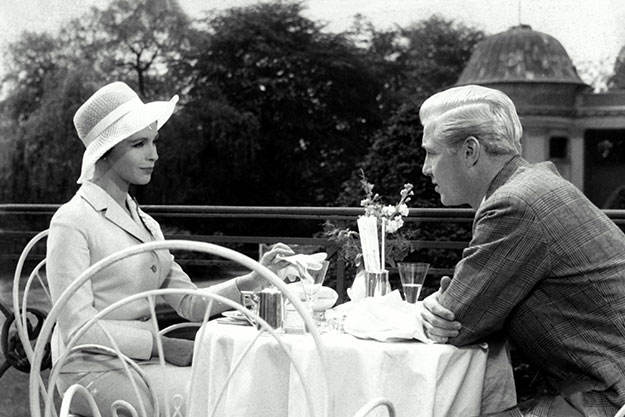
Brainwashed
Distributed by United Artists, Crime of Passion was made under the auspices of Robert Goldstein Productions, whose slender resume is filled up with mostly Westerns, including Stranger on Horseback (1955), directed by Jacques Tourneur, and two more by Oswald, The Brass Legend (1956) and Fury at Showdown (1957). The film’s ultimate commercial fortunes were apparently insufficient to stay Stanwyck’s gradual drift towards television—in her case peculiar to the needs and contingencies faced by an actress entering middle age, but also indicative of changes in the industry as a whole, changes which ultimately influenced Oswald’s career.
Oswald had a reasonably long if patchy run as a director—his last credits in that capacity are in 1985, on two episodes of the re-launched Twilight Zone—but after his streak of mid-to-late ’50s Hollywood genre films he rarely landed in one place for long enough to get comfortable and lock into a groove. He made the excellent Brainwashed (1960), from a Stefan Zweig story, in economically booming West Germany, where certain wartime emigres like old-timers Fritz Lang, John Brahm, and Robert Siodmak had returned to ply their wares, and after that managed a few stray features. Most of his credits, however, are in television, including episodes of Perry Mason with star Burr, several Outer Limits installments including the near-masterpiece “The Forms of Things Unknown,” and two entries in the original Star Trek series. On preliminary investigation, then, the case of Gerd Oswald would appear to be that of a promising film career stunted by the crumbling of the studios and the tempting inducement of regular paychecks from television, not unlike the story of, say, Don Weis.
This may be unfair: I cannot speak definitively to the quality of the nearly six hours of Gentle Ben overseen by Oswald, though I find it difficult to believe that there is anything in them that rises to the level of A Kiss Before Dying, Crime of Passion, or Brainwashed. These films provided basis enough for Andrew Sarris to praise Oswald’s “admirable consistency, both stylistically and thematically, for a director in his obscure position” and his “fluency of camera movement . . . controlled by sliding turns and harsh stops befitting a cinema of bitter ambiguity” in his The American Cinema, which assigns Oswald to “Expressive Esoterica,” and therefore recommends him to history. To this I will add that part of Oswald’s thematic consistency was an unusual level of understanding of individuals simultaneously out of step with and at the mercy of the systems which they are born into, systems which they try in vain to overmaster before falling victim to. And though Oswald’s filmography is too slim to warrant an argument that he is an overlooked major figure, this little-documented semi-German who spent most of his life in Southern California does intriguingly suggest a bridge between the individual struggles with fatalism in Lang and Fassbinder—both filmmaker maudit and missing link.
Nick Pinkerton is a regular contributor to Film Comment and a member of the New York Film Critics Circle.




